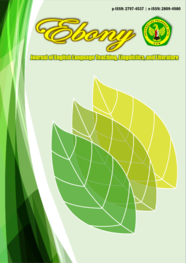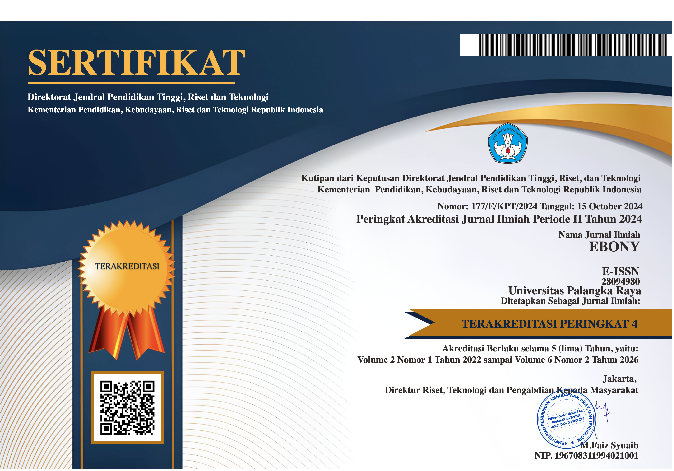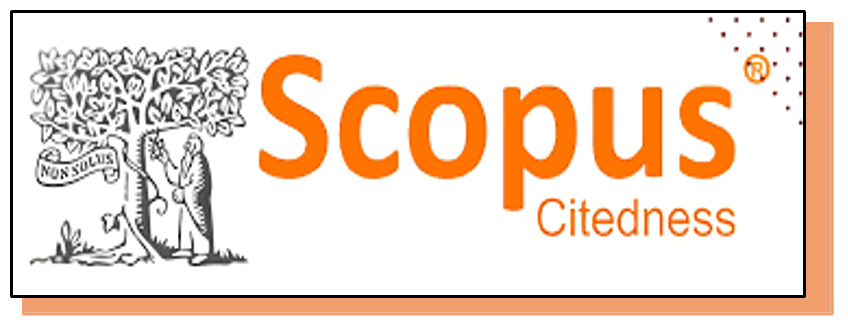Cultivating Students’ Critical Thinking and Collaboration: Literacy Practice in Digital Storytelling Project
DOI:
https://doi.org/10.37304/ebony.v5i2.21842Keywords:
literacy, digital project, digital storytelling, critical thinking, collaborationAbstract
This research explores how a teacher’s literacy practices, through a digital storytelling project, foster critical thinking and collaboration among students. It also examines students' experiences during literacy activities and the project itself. Conducted as a qualitative case study, this research involved thirty-six senior high school students. Data were gathered through classroom observations, interviews, and documentation of students’ project artifacts. The findings suggest that using reading journals during self-directed reading at home promotes critical thinking and assists students in generating ideas for their digital storytelling projects. Besides, digital storytelling projects also play a key role in enhancing students’ critical thinking and collaboration skills. Students effectively articulated issues and proposed solutions within their stories. Some topics related to the environments chosen cover air pollution, water pollution, building/housing, and illegal logging. Participation in the collaborative project encouraged students to take responsibility for their contributions and to respect differing opinions within their teams. Exploring students’ views as their reflection on experiencing literacy practices in digital storytelling projects also reveals the positive impacts on their English ability. This approach provides educators with a practical and innovative strategy to foster students’ skills, i.e. critical thinking and collaboration in the 21st century in an educational context.
Downloads
References
Aimah, S., & Purwanto, B. (2019). the Use of Teachers’ Questioning Strategies To Stimulate Students’ Critical Literacy: a Case of Two English Lecturers in Indonesia. Indonesian EFL Journal, 5(1), 27. https://doi.org/10.25134/ieflj.v5i1.160
Beckett, G. (2002). Teacher and Student Evaluations of Project-Based Instruction. TESL Canada Journal, 19(2), 52. https://doi.org/10.18806/tesl.v19i2.929
Braun, V., & Clarke, V. (2006). Qualitative Research in Psychology Using thematic analysis in psychology Using thematic analysis in psychology. Qualitative Research in Psychology, 3(2), 77–101. http://www.tandfonline.com/action/journalInformation?journalCode=uqrp20%5Cnhttp://www.tandfonline.com/action/journalInformation?journalCode=uqrp20
Budiarti, M., Ferguson-patrick, K., Macqueen, S., & Reynolds, R. (2021). Global Project-Based Learning as an Approach to Teaching the 4Cs in Schools. Journal of International Social Studies, 11(1), 33–62.
Cocco, S. (2006). Student leadership development: The contribution of project-based learning. Royal Roads University.
Cresswell, J.W. & Cresswell, J. . (2012). Research Design: Qualitative, Quantitative, and Mixed Methods Approaches. SAGE Publication.
Fisher, D., & Frey, N. (2012). Close reading in elementary schools. Reading Teacher, 66(3), 179–188. https://doi.org/10.1002/TRTR.01117
Khairuddiniyah, D. (2017). The Implementation of Literacy Strategies in Teaching English by the English Teacher at MAN Insan Cendekia Padang Pariaman. 10(20), 242–257. https://doi.org/10.2991/iconelt-17.2018.30
Kotluk, N., & Kocakaya, S. (2017). The effect of creating digital storytelling on secondary school students’ academic achievement, self efficacy perceptions and attitudes toward physics. International Journal of Research in Education and Science, 3(1), 218–227.
Krajcik, J., & Shin, N. (2014). The Cambridge handbook of the learning sciences (R. K. Sawyer (ed.)). Cambridge University Press.
Krauss, I., & Boss, S. (2013). Thinking through project-based learning: Guiding deeper inquiry. Corwin Publisher.
Kurniawati, N., Sugaryamah, D., & Hasanah, A. (2020). Proposing a model of critical literacy program for fostering Indonesian EFL students’ critical thinking skills. Journal of Education and Learning (EduLearn), 14(2), 234–247. https://doi.org/10.11591/edulearn.v14i2.15084
Larmer, J., Mergendoller, J. R., & Boss, S. (2015). Setting The Standard For Project based learning. In Engineering (Issues 1–2).
Lee, H. (2013). Telling stories and making social relations: Transnational women’s ways of belonging in intercultural contexts. Applied Linguistics, 36(2), 1–21. https://doi.org/10.1093/applin/amt038
Lee, L. (2014). Digital news stories: Building language learners’ content knowledge and speaking skills. Foreign Language Annals, 47(2), 338–356. https://doi.org/10.1111/flan.12084
Lochmiller, C. R. (2021). Conducting thematic analysis with qualitative data. Qualitative Report, 26(6), 2029–2044. https://doi.org/10.46743/2160-3715/2021.5008
Mardiana, W. (2021). Literacy Strategies: Building Elementary Students’ Character Education and English Competence in Face-To-Face and Online Classroom. Edulangue, 4(1), 46–64. https://doi.org/10.20414/edulangue.v4i1.3189
Mardiana, W., Rizky P. O., Wiwin W., & Farah A. (2022). Proyek Menulis Teks Naratif Digital Berbasis Budaya Lokal Melalui Book Creator Untuk Mendukung Kreatifitas Dan Berfikir Kritis Mahasiswa. Dialektika: Jurnal Bahasa, Sastra Dan Budaya, 9(2), 234–243. https://doi.org/10.33541/dia.v9i2.4225
Metcalfe, J., Simpson, D., Todd, I., & Toyn, M. (2013). Thinking through new literacies for primary and early years. SAGE Publication.
Putri, G. A. P. E. I. (2018). Critical environmental education in tertiary English language teaching (ELT): A collaborative digital storytelling project. Indonesian Journal of Applied Linguistics, 8(2), 336–344. https://doi.org/10.17509/ijal.v8i2.13280
Robin, B. R. (2016). The Power of Digital Storytelling to Support Teaching and Learning. Digital Education Review, 17–29.
Saimon, M., Lavicza, Z., & Dana-Picard, T. (Noah). (2023). Enhancing the 4Cs among college students of a communication skills course in Tanzania through a project-based learning model. Education and Information Technologies, 28(6), 6269–6285. https://doi.org/10.1007/s10639-022-11406-9
Vinogradova, P., Linville, H. A., & Bickel, B. (2011). “Listen to My Story and You Will Know Me”: Digital Stories as Student-Centered Collaborative Projects. TESOL Journal, 2(2), 173–202. https://doi.org/10.5054/tj.2011.250380
Yang, Y. T. C., & Wu, W. C. I. (2012). Digital storytelling for enhancing student academic achievement, critical thinking.; Learning motivation: A year-long experimental study. Computers and Education, 59(2), 339–352. https://doi.org/10.1016/j.compedu.2011.12.012
Yin, R. K. (2018). Case Study Research and Applications Design and Methods. SAGE Publications.
Downloads
Published
How to Cite
Issue
Section
License
Copyright (c) 2025 wiwik mardiana, Justsinta Sindi Alivi, Amy Krisdiana, Ika Susanti

This work is licensed under a Creative Commons Attribution 4.0 International License.











